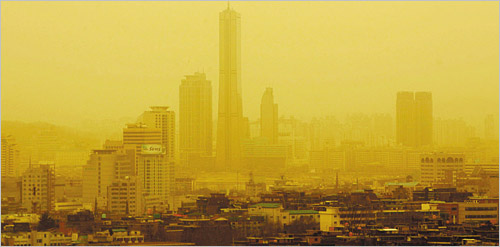Almost all parts of South Korea were blanketed on Tuesday, March 16, 2021 by a massive yellow dust storm originating from the inland deserts of northern China, the state weather agency said.

According to the Korea Meteorological Administration (KMA), almost all parts of the nation came under the influence of high levels of yellow dust that originated in the inner Mongolian region in northern China.
The vicinity of the Gobi Desert, over the weekend, was moving south by riding the northerly wind.
Seoul is shrouded with a layer of yellow dust originating from northern China on March 16.
The latest yellow dust storm was forecast to begin to weaken on Wednesday but may continue to affect the nation, depending on the flow of atmospheric pressure on the Korean Peninsula, the KMA said.
On Monday, Beijing and other Chinese cities were shrouded by what the local weather agencies call the biggest sandstorm in a decade due to the same heavy winds blowing in from the Gobi Desert and nearby regions.
The average hourly concentration of fine dust particles smaller than 10 micrometres in diameter, known as PM 10, rose to 139 microgrammes per cubic meter in Seoul, 168 microgrammes on Jeju Island, 123 microgrammes in Incheon and 153 microgrammes in Gyeonggi Province as of 3.00 p.m.
Authorities issued a fine dust advisory for 10 cities and counties in the south-western province of South Jeolla at 1.00 p.m., as the hourly average of PM 10 surged to 224 microgrammes in those regions.
The corresponding figures for Busan, Daegu, Gwangju and Daejeon were lower at 88, 26, 59 and 76 respectively, the KMA noted.
The weather authorities here categorised concentrations of PM 10 between zero and 30 microgrammes as “good,” between 31 and 80 as “normal”, between 81 and 150, as “bad” and more than 151 as “very bad”.
A fine dust advisory was issued when the PM 10 figure stays above 150 microgrammes for longer than two hours.
The Ministry of Environment has already issued a preliminary yellow dust advisory for Seoul and almost all regions, except the south-eastern provinces of Gyeongsang and Gangwon Province.
The East of the capital warned that the PM 10 reading was expected to soar above 150 micrograms in the affected regions.
As fine dust particles can cause various ailments and undermine the body’s immune system, government officials ask that citizens with respiratory or cardiovascular problems, children and other vulnerable people, refrain from going outdoors.
Citizens across the country refrained from going outside throughout the day, though they are accustomed to always wearing masks in public due to the coronavirus pandemic.
“In my daily life hit by COVID-19, walking through the park with my pet dog is an important vitality for me.
“But I gave up going out today because the yellow dust made my throat and eyes sore,’’ a woman said.
Indeed, neighbourhood parks in Seoul and other major cities were quieter than usual.
A worker in Seoul said he and his colleagues gave up going outside to buy lunch and use a boxed meal delivery service instead.
Many online chatting sites of housewives were flooded with complaints about disruptions in everyday life and physical distress caused by the influx of yellow dust.
A 61-year-old woman in the southern city of Yeosu said her eyes felt stiff and her hands got rougher after she went out for about an hour to shop for groceries.
“I hope it rains soon to wash off the yellow dust,’’ the woman prayed.
